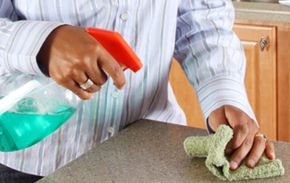\”
 \”How safe is your home?Hemera/Thinkstock
\”How safe is your home?Hemera/Thinkstock
Did you know that there are differences in what the words "danger," "caution," "poison" and "warning" mean when they\’re printed on a consumer product? It\’s true. It\’s not up to the manufacturer to choose which word best goes with the design on the product label. Instead, it\’s the type of harm it can bring to the hapless user that determines which warning term is used on a product.
"Poison," for example, is the classification that refers to the highest level of danger. It describes a product that can be deadly when inhaled, ingested or absorbed through the skin. "Flammable" describes a product that\’s, well, flammable. Other words describe products that can explode or cause mental retardation, respiratory and renal failure, chemically burned skin and so on.
Now that your eyes are open, take a few moments to look around your house, your garage and your basement. Chances are, you\’ll be startled to find that your house is filled with an array of deadly chemicals and that there are only plastic bottles and metal containers standing between you and severe injury. These products, referred to collectively as household hazardous waste (HHW), can indeed cause injury or even death. Fortunately, in addition to words of warning, manufacturers must also include directions on how to safely use their products.
All of this is to say that when you see a caution word like "Danger" or "Poison" — no matter how many times you\’ve used a product before — it\’s a good idea to read the directions.
A good rule of thumb is to prevent hazardous waste from entering your home. Look for less dangerous alternative products and if that\’s not possible, be aware of the harm a product can bring when misused. Let\’s take a look around your house to find what types of products make up HHW.
Types of Common Hazardous Wastes in the Home
As we\’ve seen, there are a number of products that are classified as household hazardous waste (HHW). Everything from the pesticide you use to keep your yard mosquito-free to the old cans of oven cleaner sitting half-used in the cabinet under your kitchen sink all pose various risks to your health and the environment.
The stuff that goes into your car to keep it running is commonly toxic. The oil that keeps the engine running picks up heavy metals during use and exposure to used oil can cause brain damage. Antifreeze ingestion can also damage the brain and lead to kidney failure. Lead-acid car batteries contain about 18 pounds (8.1 kilograms) of lead and a gallon (3.8 liters) of acid, both of which are hazardous materials.
Chemicals used around the garden also tend to be fairly toxic, especially anything that ends in "-cide." Pesticides, fungicides and herbicides are all designed to kill smaller organisms, but the lethal ingredients found in them can cause acute injury and death in humans as well. Fungicides may also be unapparent in products; they\’re commonly used in treated wood to prevent rotting, for example.
Keeping your house clean often calls for toxic chemicals that eventually become hazardous waste. Some, like mildew removers and products containing bleach, are obviously hazardous. Others, like spot removers, may seem less dangerous. Spot removers used on carpeting commonly contain the active ingredient perchlorethylene. Breathing this chemical can cause memory loss, liver failure and cancer — all things you want to avoid when keeping your house tidy.
Even seemingly innocuous products can become toxic when mishandled. Modern latex paint is also considered generally safe, especially compared to its lead-based predecessors, but can contain additives like fungicides or toxic thickening agents. Plastic products release toxic fumes when burned, for example. So incinerating an old herbicide container is a doubly bad idea; you can look forward to inhaling fumes from both the herbicide and the melted plastic.
But, of course, you\’re a smart person. You know not to incinerate plastic, but do you know what to do with used engine oil? Find out how to properly dispose of HHW on the next page.
Disposing of Hazardous Wastes in the Home
One of the more tempting methods of household hazardous waste (HHW) disposal is to simply throw the product away. After all, it\’s waste. Although this technique is the easiest, it may also be the most damaging. In a landfill, where that waste is headed, the toxic compounds found in the product will have the chance to seep into the groundwater and pollute the water supply.
While under federal law, HHW can simply be thrown away without any penalty to the individual, the environmental impact it can have is worth a little extra effort on your part. Depending on the waste, just a little can do a lot of harm: A single quart of used oil, for example, can pollute up to 250,000 gallons (946,353 liters) of drinking water because of the heavy metals found in it.
Pouring most liquid HHW down the drain is just as bad, if not worse, since it introduces harmful substances directly to the water supply. To be responsible, you\’ll want to avoid disposing of HHW in your drain — with the exception of antifreeze. This waste can be disposed of via your sink, since sewage treatment plants can break down the ethylene glycol in it. Just be sure you allow the water to run while you pour it.
The best way to dispose of HHW is to simply use it up or to find someone else who can put the material or product to its proper use. Paint can be donated to schools or charities, and pesticides can be donated to community gardens, for example. Some areas, like Seattle, Wash., maintain community materials exchange boards, where people list unwanted hazardous waste material they want to give away.
Experts recommend next looking for an official recycling program. Used car oil, car batteries and rechargeable batteries can all be recycled. Check with your local recycling plant or with a company that sells oil or batteries to see if they accept used materials. Some states, like Illinois, stage one-day, semiannual HHW collection drives.
Again, the best way to dispose of household hazardous waste is to use it up. Buy only what you will need to prevent having to store and dispose of hazardous materials. Once you\’re done with the product, rinse out the container and use it again in its diluted form three times. After three uses, the container should be able to be discarded with minimal impact to the environment or public health.









